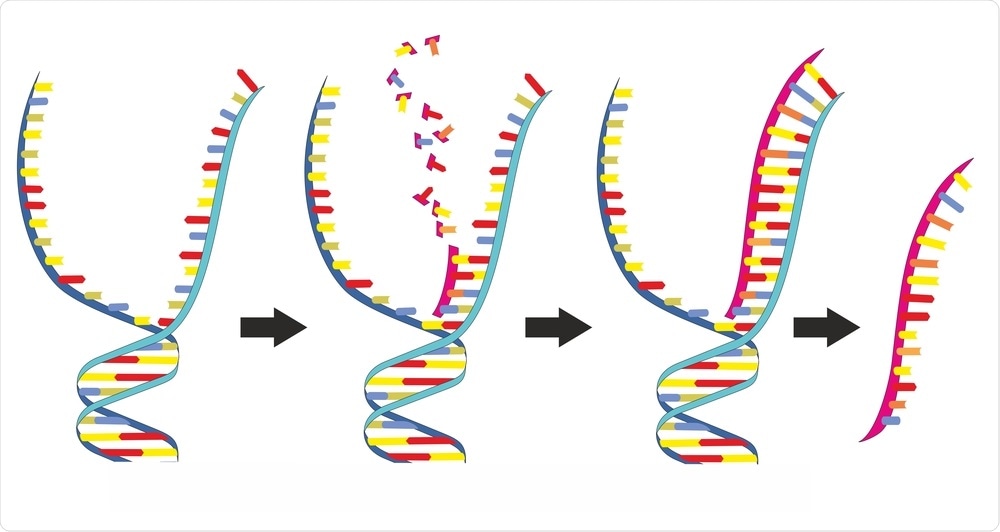An international research team from the University of Turku based in Finland and PennState University based in the United States has solved an ancient puzzle of how living organisms differentiate between DNA and RNA building blocks at the time of gene expression, offering new possibilities for designing novel antiviral medications.

Image Credit: Soleil Nordic/Shutterstock.com
These latest insights were published in the Nature Communications journal.
Two types of nucleic acids—DNA and RNA—are used by all cellular organisms to preserve, propagate, and use their genetic data. DNA synthesis is performed by certain enzymes, known as DNA polymerases, and this process is required to precisely transfer the genetic data from one generation to the next.
RNA synthesis is performed by another set of enzymes, known as RNA polymerases, and is required to use the genetic data to eventually create proteins that consequently meet the majority of catalytic and structural functions in all present-day living organisms.
The long-standing issue encountered by DNA and RNA polymerases is that the RNA and DNA building blocks cannot be distinguished easily. Such building blocks are identical except for an insignificant portion of the molecule, referred to as the 2’OH group, which is found in the RNA building blocks but not in the DNA building blocks.
DNA polymerases prevent the use of the RNA building blocks by exhibiting a cavity, known as the active site. This cavity is sufficiently large to bind the DNA building blocks but very small to accept the somewhat larger RNA building blocks. Consequently, DNA building blocks alone attach to the active site cavity and bind to the growing DNA polymer.
However, RNA polymerases are incapable of using the same approach because the smaller DNA building blocks, just like the RNA building blocks, will invariably lodge into the same active site cavity, explained Georgi Belogurov, a Senior Researcher.
RNA polymerase active site cavity deforms the DNA building blocks
To gain a deeper understanding of how RNA polymerases prevent the use of DNA building blocks, researchers from the University of Turku and led by Belogurov carried out complex biochemical measurements by utilizing RNA polymerases that were carefully modified by engineered mutations.
Simultaneously, the researchers from Penn State University in the United States and headed by Professor Katsuhiko Murakami achieved a comprehensive 3D structure of RNA polymerase with the DNA building blocks.
Through this combined study of the structural and biochemical data, Janne Mäkinen, a Doctoral Candidate and the first author of the study, along with his collaborators, found that RNA polymerase produces the active site cavity that distorts the DNA building blocks so that the latter is no longer appropriate for integration into the RNA chain.
Subsequently, the altered DNA building blocks dissociate from the RNA polymerase rather than being fixed to the growing RNA polymer, added Mäkinen.
Human and viral RNA polymerases select RNA building blocks differently—Finding enables the development of more effective antiviral drugs
The research work was funded by the Academy of Finland, Sigrid Juselius Foundation (Finland), and the National Institute of Health (USA). It has long-standing implications for translational studies.
RNA viruses, including SARS-Cov-2 that is responsible for causing the COVID-19 disease also produce RNA as a part of their infectious cycle. Belogurov further informed that viruses utilize their own RNA polymerases that are extremely different from RNA polymerases of the human cell but they also need to choose the RNA building blocks and discard the DNA building blocks.
Through meticulous comparison of the recently identified selectivity mechanism with the discoveries made by other research groups, Mäkinen and collaborators surmised that human and viral RNA polymerases employ different mechanisms to discard the DNA building blocks.
The researchers suggested that a synthetic molecule could be designed that is analogous to a DNA building block and this would selectively attach and prevent viral RNA polymerase. But this synthetic molecule will be rejected by the human RNA polymerases and, hence, will not disrupt the RNA synthesis required by the human cell.
The study paves the way for developing selective and potent antiviral medications that target viral RNA polymerases, concluded Belogurov.
Source:
Journal reference:
Mäkinen, J. J., et al. (2021) The mechanism of the nucleo-sugar selection by multi-subunit RNA polymerases. Nature Communications. doi.org/10.1038/s41467-021-21005-w.